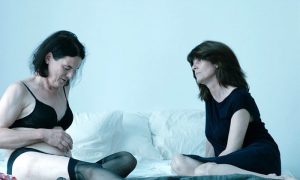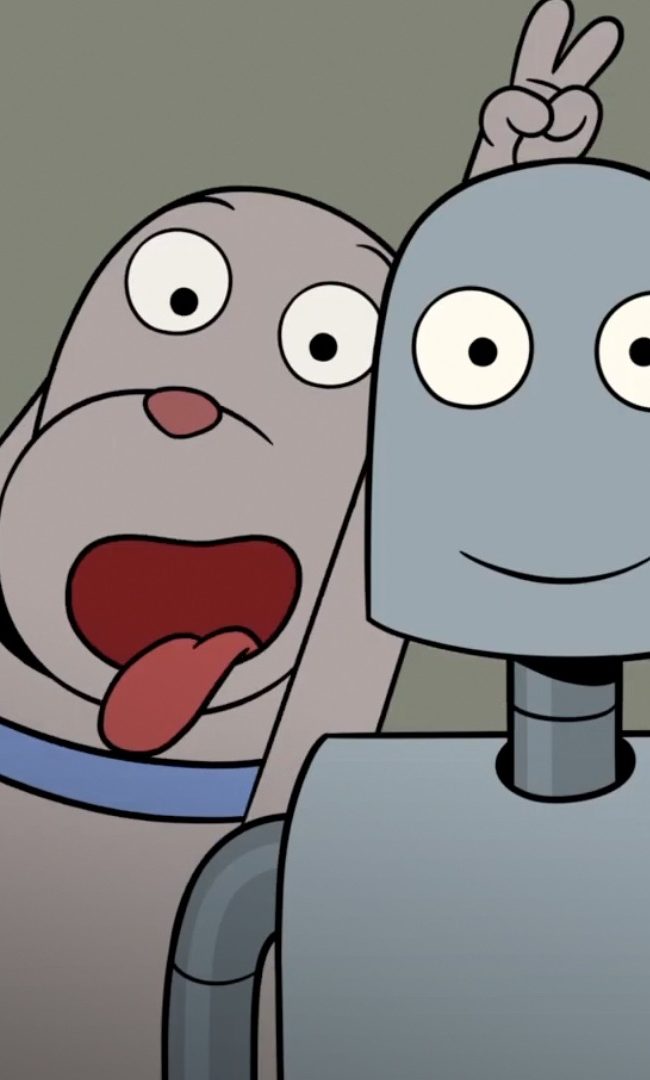A Conversation with Adina Pintille (TOUCH ME NOT)
 I met with Romanian director Adina Pintilie on Sunday, September 9, 2018, at the Toronto International Film Festival, to discuss her debut feature, Touch Me Not (which I also reviewed), which won top honors at this year’s Berlin Film Festival. The movie – a hybrid of staged, fictional and documentary elements – explores humanity’s constant search for connection, whether through physical or emotional means or a combination of both. Using trained and untrained actors, Pintilie immerses us in a world of raw feeling and desire, simultaneously titillating and unsettling. Even as Touch Me Not discomfits, however – and not just because of the often-graphic erotica (some might call it pornography) – it enlivens through its aesthetic panache. Both Pintilie and her actors/subjects often address each other and the audience through direct means, involving the viewer in visceral ways. And though the film may not be for everyone, it’s impossible to watch it and not have a strong reaction, which is (almost) always a positive. Here is a condensed digest of our conversation, edited for length and clarity.
I met with Romanian director Adina Pintilie on Sunday, September 9, 2018, at the Toronto International Film Festival, to discuss her debut feature, Touch Me Not (which I also reviewed), which won top honors at this year’s Berlin Film Festival. The movie – a hybrid of staged, fictional and documentary elements – explores humanity’s constant search for connection, whether through physical or emotional means or a combination of both. Using trained and untrained actors, Pintilie immerses us in a world of raw feeling and desire, simultaneously titillating and unsettling. Even as Touch Me Not discomfits, however – and not just because of the often-graphic erotica (some might call it pornography) – it enlivens through its aesthetic panache. Both Pintilie and her actors/subjects often address each other and the audience through direct means, involving the viewer in visceral ways. And though the film may not be for everyone, it’s impossible to watch it and not have a strong reaction, which is (almost) always a positive. Here is a condensed digest of our conversation, edited for length and clarity.
Hammer to Nail: I’d like to start with a very basic question, because there’s a lot going on in your film.
Adina Pintilie: I also have a question for you. Who starts? (laughs)
HtN: OK. Let me start, and then you can throw that question at me.
AP: OK!
HtN: So, what was the genesis of this quite visionary, and I would say hybrid, in many ways, movie?
AP: It’s good you raised this question of the impossibility to label the film in any way, because it’s not a documentary, it’s not a fiction film, and it’s not an experimental film. It’s quite important for us to be very specific about that. It’s a fusion, or as you said, a hybrid, between reality and fiction. So, it started, as I also say in the film at one point, how when I was 20, I thought I knew how things are, how relationships function, how things are with desire and beauty, but now, after many years, I realize I don’t know much about this stuff. The reality is much more complex than what I thought I knew. This is how the film started, from this intention to really forget what I think I know and try to rediscover, with fresh eyes, how people experience this.
HtN: Understood. Do you want to ask your question now, or do you want me to continue?
AP: So how, for you, was the experience of watching the film?
HtN: It took me a while to get into the film. You open, more or less, with a male erection spewing semen, so…(laughs…it just took me a while to figure out what I was watching, but where I really began to engage with the film was in the scene between Tómas and Christian. Although you had sort of hooked me earlier, with the wonderful construction of the video monitor…
AP: Of the teleprompter.
HtN: Of the teleprompter, with your face as an ethereal image. I really started to perk up there, and then in the scene I refer to as “spiritual yoga”…
AP: The workshop.
HtN: …in the scene between Tómas and Christian. And then from that point on, I was in, and I found it very engaging, though occasionally challenging, but in a good way.
AP: So basically, what helped you enter into a dialogue with the film was this meta-film construction, with the presence of the filmmaker and of the apparatus. This, I think, is quite an important aspect of the film, because the film is, above everything, a research process. You know, there are both professional and nonprofessional actors. I hesitate to call them actors. They are both professional and nonprofessional, but it doesn’t matter if they are professional or not. I was just searching for people who are on the same wavelength as me and wanted to share this process of research and self-interrogation with me. The casting was atypical. It was more like for nonfiction work, where you really need to get to know the other person.
The film was, from the very beginning, conceived as a dialogue. So, the fourth wall was never there. This is why, initially, it was supposed to be as if these people were sharing with you, the viewer, from time to time, part of their personal research. From this came the conceptual and technical necessity of the device. It was important that the characters are talking to you all the time, with direct eye contact. At the very beginning, however, the camera was not supposed to be in the film. But the notion of dialogue that you have with the viewer, and the invitation that you launch to the viewer to look into his own experience and to question his own references about intimacy and stuff, was there.
And in the moment when we assembled everything, we had these moments when the protagonists were exploring their intimacy, and then from time to time they would talk to us, directly, we realized that the method doesn’t reach the emotional purpose, because those moments when the protagonists would talk to you would take you out of the emotional flow. It was a distancing, Brechtian effect, instead of creating the emotional bridge that we intended. And this is how the presence of the camera became necessary.
The teleprompter is not a recent invention, as it comes from television, and also Errol Morris uses it many documentaries, and it became necessary to bring it – the so-called apparatus – into the film, to understand that this is not a bubble. We are so used to watching cinema in a certain way. We go to the movies, and you have that story on screen, so you separate from yourself to go into the bubble of story, and it’s another life, no matter if it’s fiction or nonfiction. It’s not you; you are not involved. And for me, from the very beginning, it was very important that the viewer is all the time involved with the process.

Our Chris Reed and filmmaker Adina Pintille
HtN: That’s fascinating. So, that was your way of getting the viewer to feel as if they were peering inside the intimacy of these characters.
AP: Exactly. Because, basically, the camera functions more like a witness and a bridge. It’s like a communication bridge between these very special people, who are sharing some really intimate areas of their lives, and the viewer. And this dialogue was not supposed to be just one way. It was supposed to also trigger a sort of inner process.
HtN: Well, I think you succeed very much in that. Speaking of casting, where did you find Laura Benson and Tómas Lemarquis? I had seen him before, as he has been in some mainstream films, but I had never seen her before, except maybe years ago in Dangerous Liaisons.
AP: She worked a lot with Patrice Chéreau, both in theater and in film.
HtN: Right. She works a lot in France, I read.
AP: Yes. She’s based in Paris, but she’s British. She’s also an acting teacher. As I mentioned, it was a very atypical casting, because it was not about people playing a role. They brought a lot of their personal material, but also fictional elements. We staged situations. For example, we worked with their memories, we re-enacted memories with other people. We had many fictionalizing procedures, which functioned like a safety net. We created, through fictionalizing and staging, a sort of laboratory, a safe space, which allowed us to explore areas which otherwise would have been much more difficult to explore.
In a classical fiction film, you are limited; you have to be a character that is written before. In a classical documentary, you are again limited by a certain sort of pressure to be yourself, because it’s a film about the real you and your real life. The paradox of this hybrid situation, this fusion, was that this combination allowed you to go into certain places, because your privacy was protected. Nobody needed to know where you brought the material from.
HtN: Right. Is it real, is it fiction? It doesn’t matter.
AP: It doesn’t matter. And also, this keeps the privacy of the protagonists in a situation where they had to go into very vulnerable places in front of the camera, in front of the crew, in front of people they didn’t know. So, this was a sort of protective environment, in which they could go into places they would never have dared go into, in real life. Or into places of memory or imagination. This was fascinating about the process. It was sort of an expanded self that they explored in the film.
HtN: Right. Now, emotional protection or not, they are still exposing themselves physically in a way that a lot of people do not, on screen. I’m curious how you worked up to that. Your two main actors really expose quite a lot of themselves, as does Christian. It’s a wonderful metaphor for an emotional baring of soul. How did you work up to that level of comfort?
AP: You know, Laura answers this question at one point, and she gives a beautiful answer. She says, “There are nakednesses which are much more difficult than the physical one.” The film is about the body. It’s about our body, it’s about our intimacy, it’s about sexuality, it’s about this very natural part of our lives, which is so difficult to approach. It’s so difficult to talk about.
We knew, from the start, that we wanted to go into a research on this theme, but we didn’t know where it will go. By the very nature of the research, it’s searching. You don’t know what will come. It was a long process in which we had to reach a certain level of trust, and a level of intimacy with the camera, because the camera is all the time present, so they had to get used to the camera. We worked on Skype, at first, because everyone was in different places.
HtN: I was going to ask where you actually shot the film.
AP: So, this is a very European film, in many respects. It’s a co-production between five countries: Romania, Bulgaria, the Czech Republic, Germany and France. It’s European not only in terms of budget structure, but also in terms of team. The protagonists come from Bulgaria, from the UK, from Australia, France, Iceland, and Romania, and several more countries. And the creative teams also come from several countries. And for the space in the film, we tried to create a non-identified, geographic space, which can be any city from our Western world. And then, it’s very important because this is a topic which is going beyond borders. It’s a borderless film in many senses, and the focus was actually about bodies. The body was very important as a landscape, as you see in the very beginning.
HtN: Yes. You have this tracking shot along the human body, and you don’t quite know what you’re looking at, yet. Obviously, once you see genitalia, you know what you’re looking at, but that skin, and hair, and then that heaving chest…yes, definitely a landscape.

A still from “Touch Me Not”
AP: It’s like an unknown planet. The film is very much about exploring this area between the two bodies, between your body and my body, both physically and metaphorically. The notion of the taboo around the nakedness is different in different cultures. The Nordic cultures are so much more relaxed, and they go into saunas with their families naked and it’s not a problem. In other countries, more in the Christian belt, it’s more problematic, because body and physicality are automatically charged with a sexual burden.
HtN: What is it like in Romania?
AP: In Romania, it’s quite a traditional society, but there are different degrees. It depends on family, it depends on education and all this kind of stuff. There is a cultural taboo around nakedness, but the film explores, or at least is trying to explore, beyond this. So, from the very beginning, we are exploring that. You know that it’s discovering a new planet, a new landscape, which is inspiring fascination, fear. It’s about that area between two human beings and that area of negotiation that separates us but also gets us together. Nakedness, per se … we all have a body, we all have sexual organs, we are all made the same. I don’t think this is a border to get stopped by. But if you want to look into intimacy, this body area is very important, in terms of research.
And unavoidably, the film is questioning this. When you start to work with real life, life is so different from your normative fictions. You discover that there are so many bodies, which are completely different than the normative bodies. There are so many beauties that are different than the so-called norm. For example, if you ask me about Christian, if you ask me about Hanna…Christian has one of the most harmonious relationships with his own body than that among many people I know.
What was important for me, in the beginning, when I searched for these people, was that they have a strong emotional motivation to be a part of this research, because it’s not only research about your own intimacy, sexuality and stuff, but it’s also something that you share with the camera and the viewer. It becomes public, to a certain degree. So, for Christian, the purpose was very clear. From the very beginning, he said that he was not afraid: “Many people see us, the people with differently abled bodies, as people without a sexual life. Just people who need to be helped and protected. But actually, this kind of attitude is very patronizing and offensive. For me, it’s very important to express that I have the same desires, the same needs, and I am a sexual being, and I want to express myself as a sexual being.”
For me, this was very important to share, in the film. The [sex] club scene, which is one of the most debated scenes in the film, was very important, and he is the best defender of the scene. He was actually insisting to have a scene like that. He told me, “Adina, if you show me just in this kind of medical settings, you fall into the same cliché of representation of people with differently abled bodies.” But he and Grit – they are a couple in real life – they have these kinds of explorations. So, for them, it was important to share that part of their lives.
HtN: Well, we have to end there, but congratulations on the film. It’s profound in many ways. I’m so happy that I saw it and had a chance to write about it.
AP: Thank you!
Touch Me Not will have its New York premiere at MoMA on Jan 11, 2019…
– Christopher Llewellyn Reed (@ChrisReedFilm)











